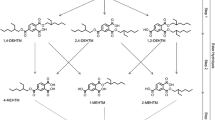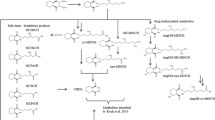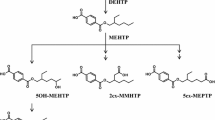Abstract
Aniline is an important source material in the chemical industry (e.g., rubber, pesticides, and pharmaceuticals). The general population is known to be ubiquitously exposed to aniline. Thus, assessment of aniline exposure is of both occupational and environmental relevance. Knowledge on human metabolism of aniline is scarce. We orally dosed four healthy male volunteers (two fast and two slow acetylators) with 5 mg isotope-labeled aniline, consecutively collected all urine samples over a period of 2 days, and investigated the renal excretion of aniline and its metabolites by LS-MS/MS and GC–MS. After enzymatic hydrolysis of glucuronide and sulfate conjugates, N-acetyl-4-aminophenol was the predominant urinary aniline metabolite representing 55.7–68.9 % of the oral dose, followed by the mercapturic acid conjugate of N-acetyl-4-aminophenol accounting for 2.5–6.1 %. Acetanilide and free aniline were found only in minor amounts accounting for 0.14–0.36 % of the dose. Overall, these four biomarkers excreted in urine over 48 h post-dose represented 62.4–72.1 % of the oral aniline dose. Elimination half-times were 3.4–4.3 h for N-acetyl-4-aminophenol, 4.1–5.5 h for the mercapturic acid conjugate, and 1.3–1.6 and 0.6–1.2 h for acetanilide and free aniline, respectively. Urinary maximum concentrations of N-acetyl-4-aminophenol were reached after about 4 h and maximum concentrations of the mercapturic acid conjugate after about 6 h, whereas concentrations of acetanilide and free aniline peaked after about 1 h. The present study is one of the first to provide reliable urinary excretion factors for aniline and its metabolites in humans after oral dosage, including data on the predominant urinary metabolite N-acetyl-4-aminophenol, also known as an analgesic under the name paracetamol/acetaminophen.


Similar content being viewed by others
References
Albert O, Desdoits-Lethimonier C, Lesne L, Legrand A, Guille F, Bensalah K, Dejucq-Rainsford N, Jegou B (2013) Paracetamol, aspirin and indomethacin display endocrine disrupting properties in the adult human testis in vitro. Hum Reprod 28(7):1890–1898. doi:10.1093/humrep/det112
American Conference of Governmental Industrial Hygienists (1992) Occupational Safety and Health Guideline for Aniline. http://www.cdc.gov/niosh/docs/81-123/pdfs/0033-rev.pdf. Accessed 24 Mar 2015
An JH, Lee HJ, Jung BH (2012) Quantitative analysis of acetaminophen and its six metabolites in rat plasma using liquid chromatography/tandem mass spectrometry. Biomed Chromatogr. doi:10.1002/bmc.2737
Andrews RS, Bond CC, Burnett J, Saunders A, Watson K (1976) Isolation and identification of paracetamol metabolites. J Int Med Res 4(4 Suppl):34–39
Bolt HM, Selinski S, Dannappel D, Blaszkewicz M, Golka K (2005) Re-investigation of the concordance of human NAT2 phenotypes and genotypes. Arch Toxicol 79(4):196–200. doi:10.1007/s00204-004-0622-8
Brandlistuen RE, Ystrom E, Nulman I, Koren G, Nordeng H (2014) Prenatal paracetamol exposure and child neurodevelopment: a sibling-controlled cohort study. Int J Epidemiol 42(6):1702–1713. doi:10.1093/ije/dyt183
Christiansen S, Kortenkamp A, Axelstad M, Boberg J, Scholze M, Jacobsen PR, Faust M, Lichtensteiger W, Schlumpf M, Burdorf A, Hass U (2012) Mixtures of endocrine disrupting contaminants modelled on human high end exposures: an exploratory study in rats. Int J of Androl 35(3):303–316. doi:10.1111/j.1365-2605.2011.01242.x
Deutsche Forschungsgemeinschaft (1993) Aniline (MAK value documentation). The MAK collection for occupational health and safety. Occup Toxic VCH 6:17–36. doi:10.1002/3527600418.mb6253e0006
Dierkes G, Weiss T, Modick H, Käfferlein HU, Brüning T, Koch HM (2014) N-Acetyl-4-aminophenol (paracetamol), N-acetyl-2-aminophenol and acetanilide in urine samples from the general population, individuals exposed to aniline and paracetamol users. Int J Hyg Environ Health 217(4–5):592–599. doi:10.1016/j.ijheh.2013.11.005
el-Bayoumy K, Donahue JM, Hecht SS, Hoffmann D (1986) Identification and quantitative determination of aniline and toluidines in human urine. Cancer Res 46(12 Pt 1):6064–6067
European Chemicals Bureau (2004) EU Summary Risk Assessment Report Aniline. http://echa.europa.eu/documents/10162/0abd36ad-53de-4b0f-b258-10cf90f90493. Accessed 24 March 2015
Grant DM, Tang BK, Kalow W (1983) Polymorphic N-acetylation of a caffeine metabolite. Clin Pharmacol Ther 33(3):355–359
Grover P (1989) Chemical carcinogenesis and mutagenesis: advances in tobacco carcinogesis. 2. Cigarette smoke. Springer, London
Human Biomonitoring Commission of the German Federal Environment Agency (2011) Stoffmonographie und -Referenzwerte für -monocyklische Amino-aromaten im Urin. Stellungnahme der Kommission Human--Biomonitoring des Umweltbundesamtes. Bundesgesundheitsbl 54(5):650–663. doi:10.1007/s00103-011-1256-7
Jaffe M (1886) Über den Niederschlag, welchen Pikrinsäre in normalem Harn erzeugt und über eine neue Reaction des Kreatinins. Physiol Chem 10:391
Jenkins FP, Robinson JA, Gellatly JB, Salmond GW (1972) The no-effect dose of aniline in human subjects and a comparison of aniline toxicity in man and the rat. Food Cosmet Toxicol 10(5):671–679
Jensen MS, Rebordosa C, Thulstrup AM, Toft G, Sørensen HT, Bonde JP, Henriksen TB, Olsen J (2010) Maternal use of acetaminophen, ibuprofen, and acetylsalicylic acid during pregnancy and risk of cryptorchidism. Epidemiology 21(6):779–785. doi:10.1097/EDE.0b013e3181f20bed
Kao J, Faulkner J, Bridges JW (1978) Metabolism of aniline in rats, pigs and sheep. Drug Metab Dispos 6(5):549–555
Korinth G, Weiss T, Penkert S, Schaller KH, Angerer J, Drexler H (2006) Percutaneous absorption of aromatic amines in rubber industry workers: impact of impaired skin and skin barrier creams. Occup Environ Med 64(6):366–372. doi:10.1136/oem.2006.027755
Kütting B, Göen T, Schwegler U, Fromme H, Uter W, Angerer J, Drexler H (2009) Monoarylamines in the general population—a cross-sectional population-based study including 1004 Bavarian subjects. Int J Hyg Environ Heal 212(3):298–309. doi:10.1016/j.ijheh.2008.07.004
Ladds G, Wilson K, Burnett D (1987) Automated liquid chromatographic method for the determination of paracetamol and six metabolites in human urine. J Chromatogr 414(2):355–364
Lewalter J, Gries W (2000) Haemoglobin adducts of aromatic amines: aniline, o-, m- and p-toluidine, o-anisidine, p-chloroaniline, α-and β-naphthylamine, 4-aminodiphenyl, benzidine, 4,4′-diaminodiphenylmethane, 3,3′-dichlorobenzidine. Anal Hazard Subst Biol Mater. doi:10.1002/3527600418.biha_aame0007
Lewalter J, Korallus U (1985) Blood protein conjugates and acetylation of aromatic amines. New findings on biological monitoring. Int Arch Occup Environ Health 56(3):179–196
Liew Z, Ritz B, Rebordosa C, Lee P, Olsen J (2014) Acetaminophen use during pregnancy, behavioral problems, and hyperkinetic disorders. JAMA Pediatr 168(4):313–320. doi:10.1001/jamapediatrics.2013.4914
MAK value documentation in German language (1992) Anilin [MAK Value Documentation in German language, 1992]
Modick H, Schütze A, Pälmke C, Weiss T, Brüning T, Koch HM (2013) Rapid determination of N-acetyl-4-aminophenol (paracetamol) in urine by tandem mass spectrometry coupled with on-line clean-up by two dimensional turbulent flow/reversed phase liquid chromatography. J Chromtogr B 925:33–39. doi:10.1016/j.jchromb.2013.02.023
Modick H, Weiss T, Dierkes G, Brüning T, Koch HM (2014) Ubiquitous presence of paracetamol in human urine: sources and implications. Reproduction 147(4):R105–R117. doi:10.1530/REP-13-0527
Nielsen JK, Modick H, Mørck TA, Jensen JF, Nielsen F, Koch HM, Knudsen LE (2015) N-acetyl-4-aminophenol (paracetamol) in urine samples of 6–11-year-old Danish school children and their mothers. Int J Hyg Environ Health 218:28–33. doi:10.1016/j.ijheh.2014.07.001
Palmiotto G, Pieraccini G, Moneti G, Dolara P (2001) Determination of the levels of aromatic amines in indoor and outdoor air in Italy. Chemosphere 43(3):355–361
Philippat C, Giorgis-Allemand L, Chevrier C, Cordier S, Jégou B, Charles M, Slama R (2011) Analgesics during pregnancy and undescended testis. Epidemiology 22(5):747–749. doi:10.1097/EDE.0b013e318225bf33
Rebordosa C, Kogevinas M, HorváthPuhó E, Nørgård B, Morales M, Czeizel AE, Vilstrup H, Sørensen HT, Olsen J (2008) Acetaminophen use during pregnancy: effects on risk for congenital abnormalities. Am J Obstet Gynecol 198(2):178.e1–178.e7. doi:10.1016/j.ajog.2007.08.040
Rebordosa C, Kogevinas M, Bech BH, Sorensen HT, Olsen J (2009) Use of acetaminophen during pregnancy and risk of adverse pregnancy outcomes. Int J Epidemiol 38(3):706–714. doi:10.1093/ije/dyp151
Riffelmann M, Müller G, Schmieding W, Popp W, Norpoth K (1995) Biomonitoring of urinary aromatic amines and arylamine hemoglobin adducts in exposed workers and nonexposed control persons. Int Arch Occup Environ Health 68(1):36–43
Thompson JM, Waldie KE, Wall CR, Murphy R, Mitchell EA (2014) Associations between acetaminophen use during pregnancy and ADHD symptoms measured at Ages 7 and 11 years. PLoS One 9(9):e108210. doi:10.1371/journal.pone.0108210
Weiss T, Angerer J (2002) Simultaneous determination of various aromatic amines and metabolites of aromatic nitro compounds in urine for low level exposure using gas chromatography-mass spectrometry. J Chromatogr B 778(1–2):179–192
Author information
Authors and Affiliations
Corresponding author
Ethics declarations
Conflict of interest
The authors declare that they have no conflict of interest. The present work was completely financed by the Institute for Prevention and Occupational Medicine of the German Social Accident Insurance Institute of the Ruhr-Universität Bochum (IPA).
Electronic supplementary material
Below is the link to the electronic supplementary material.
Rights and permissions
About this article
Cite this article
Modick, H., Weiss, T., Dierkes, G. et al. Human metabolism and excretion kinetics of aniline after a single oral dose. Arch Toxicol 90, 1325–1333 (2016). https://doi.org/10.1007/s00204-015-1566-x
Received:
Accepted:
Published:
Issue Date:
DOI: https://doi.org/10.1007/s00204-015-1566-x




